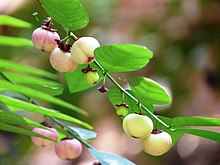Breynia androgyna
| Sauropus androgynus | |
|---|---|

| |
| Scientific classification | |
| Kingdom: | |
| (unranked): | |
| (unranked): | |
| (unranked): | |
| Order: | |
| Family: | |
| Tribe: | |
| Subtribe: | |
| Genus: | |
| Species: | S. androgynus
|
| Binomial name | |
| Sauropus androgynus | |
| Synonyms[2][3] | |
|
List
| |
Sauropus androgynus, also known as katuk, star gooseberry, or sweet leaf, is a shrub grown in some tropical regions as a leaf vegetable. In Chinese it is called mani cai (马尼菜); in Japan it is called amame shiba (アマメシバ); in Malay it is called cekur manis, sayur manis, or asin-asin;[4][5] in Thai it is called pak waan; in Vietnamese, it is called rau ngót;in Philippines,it is called Chinese Malunggay and in Kerala, India it is called madhura cheera.
Its multiple upright stems can reach 2.5 meters high and bear dark green oval leaves 5–6 cm long.
It is one of the most popular leaf vegetables in South Asia and Southeast Asia and is notable for high yields and palatability.[6] The shoot tips have been sold as tropical asparagus. In Vietnam, the locals cook it with crab meat, minced pork or dried shrimp to make soup. In Malaysia, it is commonly stir-fried with egg or dried anchovies. The flowers and small purplish fruits of the plant have also be eaten In Indonesia, the leaves of the plant are used to make infusion, believed to improve the flow of breast milk for breastfeeding mothers.
It is a good source of vitamin K.[citation needed] However, a study has suggested that excessive consumption of juiced Katuk leaves (due to its popularity for body weight control in Taiwan in the mid '90s) can cause lung damage, due to its high concentrations of the alkaloid papaverine.[7]
It also has high level of provita-min A carotenoids, especially in freshly picked leaves, as well as high levels of vitamins B and C, protein and minerals. The more the leaves mature, the higher the nutrient content of the leaves.[8] Latest studies indicate that Cekur manis encouraged rapid regeneration and multiplication through organogenesis and somatic embryogenesis.[9]
It is common in evergreen forest and cultivated up to 1,300 m [10]
Medical
Consumption of Sauropus androgynus has been reported as being associated with bronchiolitic disease [11] [12]
Nutrition
Sauropus androgynus is rich in Vitamin C and polyphenols, such as tannin.
| Nutritional value per 100 g (3.5 oz) | |||||||||||||||||||||||||
|---|---|---|---|---|---|---|---|---|---|---|---|---|---|---|---|---|---|---|---|---|---|---|---|---|---|
| Energy | 245 kJ (59 kcal) | ||||||||||||||||||||||||
11 g | |||||||||||||||||||||||||
1 g | |||||||||||||||||||||||||
4.8 g | |||||||||||||||||||||||||
| |||||||||||||||||||||||||
| Other constituents | Quantity | ||||||||||||||||||||||||
| Water | 91.4 g | ||||||||||||||||||||||||
| †Percentages estimated using US recommendations for adults,[13] except for potassium, which is estimated based on expert recommendation from the National Academies.[14] | |||||||||||||||||||||||||
-
Leaves and fruits Sauropus androgynus
-
Sauropus androgynus
References
- ^ Under its currently accepted name of Sauropus androgynus (from its basionym Clutia androgyna) this species was published in Bulletin of the Bureau of Forestry, Philippine Islands. Manila 1: 30. 1903. "Name - Sauropus androgynus (L.) Merr". Tropicos. Saint Louis, Missouri: Missouri Botanical Garden. Retrieved November 18, 2012.
Basionym: Clutia androgyna L.
- ^ The basionym of S. androgynus (Clutia androgyna) was originally described and published in Mantissa Plantarum 1: 128. 1767. "Name - Clutia androgyna L." Tropicos. Saint Louis, Missouri: Missouri Botanical Garden. Retrieved November 18, 2012.
- ^ "TPL, treatment of Sauropus androgynus". The Plant List; Version 1. (published on the internet). Royal Botanic Gardens, Kew and Missouri Botanical Garden. 2010. Retrieved November 18, 2012.
- ^ Coope, A.E. (1993). Malay-English, English-Malay Dictionary (Rev. ed.). New York: Hippocrene Books. pp. 18, 61. ISBN 0-7818-0103-6.
- ^ Bangchik (2009-10-08). "Cups in the air. asin-asin". Retrieved 2010-05-18.
- ^ Nutritive value of Sauropus androgynus
- ^ Kao CH; Ho YJ; Wu CL; ChangLai SP (1999). "Using 99mTc-DTPA Radioaerosol Inhalation Lung Scintigraphies to Detect the Lung Injury Induced by Consuming Sauropus androgynus Vegetable and Comparison with Conventional Pulmonary Function Tests". Respiration. 66 (1). Karger AG: 46–51. doi:10.1159/000029336. PMID 9973690. Retrieved 2010-05-18.
- ^ 19.1 Sauropus androgynus (sweet leaf bush)
- ^ Faculty of Science Research Seminar: Elicitors Effect on in vitro Cultures of Sauropus Androgynus, University of Nottingham Malaysia Campus
- ^ Sauropus androgynus (L.) Merr
- ^ [1]
- ^ [2]
- ^ United States Food and Drug Administration (2024). "Daily Value on the Nutrition and Supplement Facts Labels". FDA. Archived from the original on 2024-03-27. Retrieved 2024-03-28.
- ^ National Academies of Sciences, Engineering, and Medicine; Health and Medicine Division; Food and Nutrition Board; Committee to Review the Dietary Reference Intakes for Sodium and Potassium (2019). Oria, Maria; Harrison, Meghan; Stallings, Virginia A. (eds.). Dietary Reference Intakes for Sodium and Potassium. The National Academies Collection: Reports funded by National Institutes of Health. Washington, DC: National Academies Press (US). ISBN 978-0-309-48834-1. PMID 30844154. Archived from the original on 2024-05-09. Retrieved 2024-06-21.


